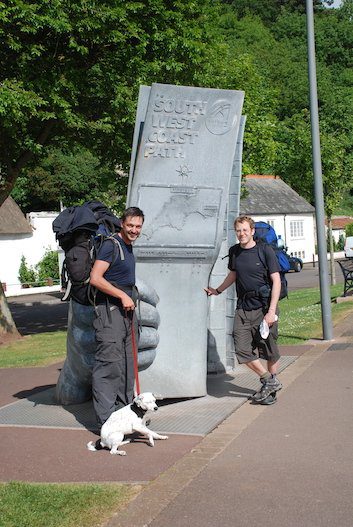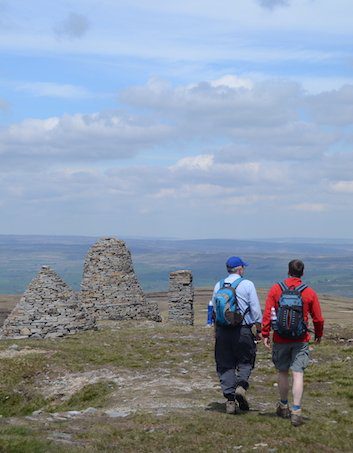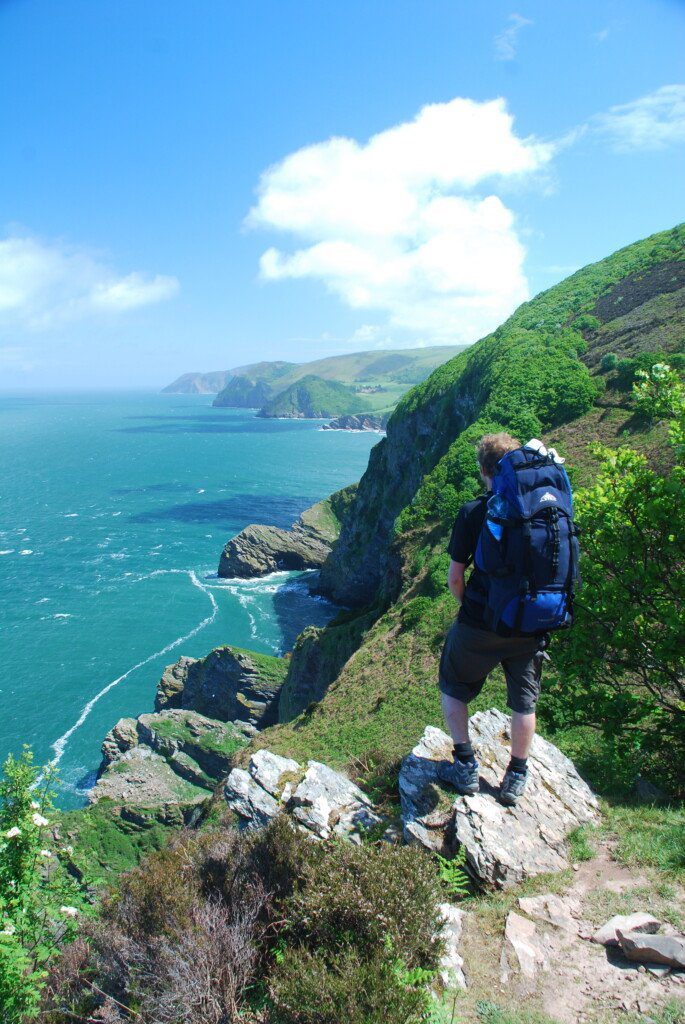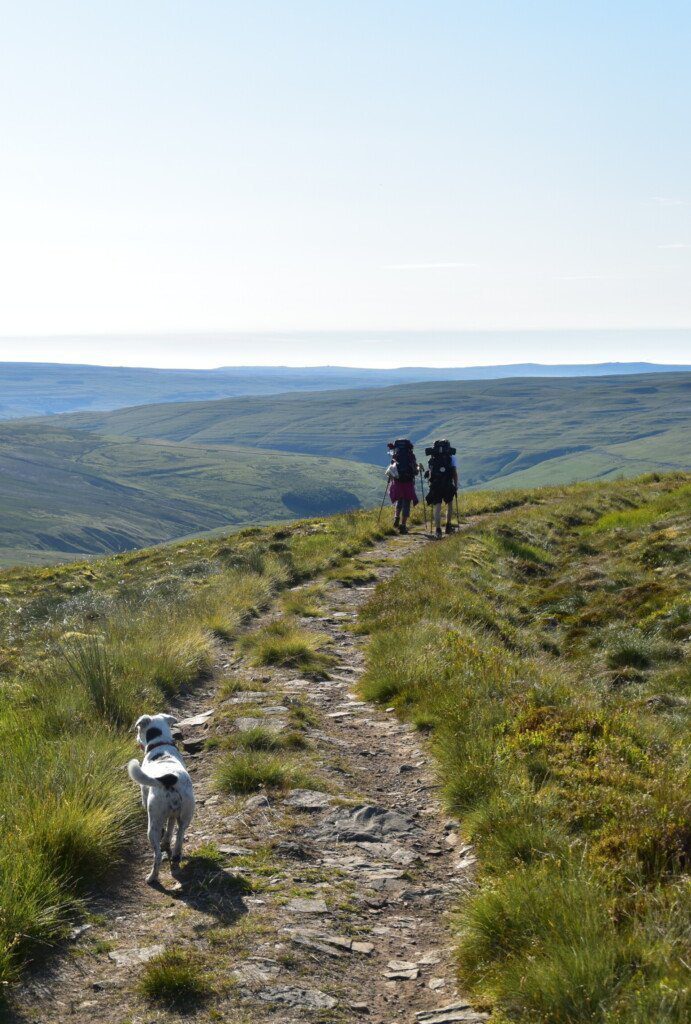What to wear & what to carry on your long-distance walk
I’ve organised this page as follows:
Written in blue (on the left-hand side of the page on every screen except mobiles) you’ll find pretty standard, generic information on what you should take on your hike. It’s the sort of information that you’ll find in all the guide books and most of the websites too.
Written in black (on the right-hand side of the screen except on mobiles), you’ll find how I personally pack for my odyssey. At the age of fifty and after 25 years of trekking, and writing about trekking, I think I’ve finally – finally! – perfected the art of packing for the trail; and thought it would be useful to share this ‘wisdom’ with you. Note that this is just what works for me; I’m not pretending it will work for everyone – but hopefully you may find some useful tips there.
| Table of contents | |
|---|---|
| Introduction | |
| How to carry it | Toiletries & First-aid kit |
| Footwear | Camping gear |
| Clothes | General items & Money |
THE GOLDEN RULE OF PACKING:
TAKE ONLY THE BARE ESSENTIALS!
This one rule should influence every decision you make when packing your bag for a trail. Obviously if you’re hiring a company to convey your luggage for you along the trail then you can be a bit more flexible with this rule. But the level of enjoyment on your walk is inversely proportional to the amount you’re carrying.
So when it comes to packing your bag, keep it light and keep it small.PACKING AND CARRYING YOUR STUFF FOR A LONG-DISTANCE HIKE
How to pack and carry your luggage – the usual advice
Carry all your stuff in a rucksack, of course. Preferably one that you’ve spent some time choosing, trying on in the shop and adjusting the straps to ensure it fits well. Make sure the hip belt and chest strap (if there is one) are fastened tightly as this helps distribute the weight with most of it being carried on your hips.
If you are camping and cooking for yourself you will probably need a 70- to 95-litre rucksack, which should be large enough to carry a small tent, sleeping bag, cooking equipment, crockery, cutlery and food.

Beginning the South-West Coast Path, Minehead. Note over-large bags – perhaps why I sustained a knee injury on this trip!
How I like to pack and carry my luggage
I now pack all my stuff into a rucksack that has a capacity of only 30 litres. In addition, I have a camera bag that I wear on my front.
Between them I carry all clothes, camping gear, clothes, toiletries, Daisy-related stuff – as well as all the items I need to enable me to research and write the guide.
The camera bag contains not only my camera but my notebook, pens, wallet, GPS, batteries, sweets, doggy poo bags, guidebook and maps – almost everything, basically, that I may need during the day on the trail.
FOOTWEAR FOR YOUR LONG-DISTANCE WALK
Footwear – the usual advice
Your footwear is arguably the most important item of gear that can affect the enjoyment of your hike.
In summer on some of the lighter trails you can get by with a light pair of running trainers or trail shoes, especially if you’re carrying only a small pack, although this is an invitation for wet, cold feet if there is any rain.
(By ‘lighter trails’ we mean the South Downs Way, North Downs Way, Thames Path and The Ridgeway.)
Perhaps more importantly, they don’t offer support for your ankles.
What I wear on my feet
When it comes to boots, the standard advice is pretty much spot on and I’ve little to add. This is the one part of my kit where I regularly spend a bit more money.
Many days spent hobbling along trails because of blisters have proved to me the wisdom of having decent, comfortable boots that are properly broken in.
I’ve noticed that nothing gives me blisters faster than a pair of boots that have failed to keep the water out.
So I make sure my boots are properly waterproof too.
CLOTHES FOR LONG-DISTANCE HIKE
Clothes – the standard advice
Experienced walkers will know the importance of wearing the right clothes. Always expect the worst weather even if the forecast is good. Modern technology in outdoor attire can seem baffling but it basically comes down to the old multi-layer system: a base layer to transport sweat away from your skin; a mid-layer to keep you warm; and an outer layer or ‘shell’ to protect you from the rain.
Regarding underwear, as with socks, two or three changes of whatever your normal underwear is fine. Cotton absorbs sweat, trapping it next to the skin which will chill you rapidly when you stop exercising.

Sensibly compact packing on the Coast to Coast Path (Nine Standards Rigg).
What I wear on my walks
For the top half, I have one decent thermal base layer. But I don’t wear this when I’m walking. It’s for when I’ve finished on the trail for the day, and want to be comfortable.
On the trail I wear regular T-shirts that all have the same quality: they are either stained, have holes in, or I simply don’t like the design of them.
In other words, on the trail I wear T-shirts that I don’t mind getting ruined.
If they have any wicking quality or thermal properties, that’s great – but I don’t go out of my way to look for them.
TOILETRIES & A FIRST-AID KIT FOR YOUR LONG-DISTANCE HIKE
Toiletries and a first-aid kit – the standard advice
Take only the minimum: unless staying in B&Bs, you’ll need a small bar of soap or small bottle of shower gel, either of which can also be used instead of shaving cream and for washing clothes; a tiny tube of toothpaste and a toothbrush; and one roll of loo paper in a plastic bag.
If you are planning to defecate outdoors you will also need a lighter for burning the paper and a lightweight trowel for burying the evidence.
My toiletries and first-aid kit
I recognise that people will have very different requirements (eg medicines etc) and standards than me in the toiletry department, but this is what I carry:
- A travel toothbrush
- Toothpaste (again, preferably travel size, or at least half-used),
- Small bottle of shower gel (usually decanted from a bigger bottle that I’ve left at home),
- Ear-plugs (take up no room and can be vital for a good night’s sleep),
Camping gear – the standard advice
Campers need a decent tent (or bivvy bag if you enjoy travelling light) that’s able to withstand wet and windy weather; a two- to three-season sleeping bag (but obviously in winter a warmer one is a good idea and on hot summer nights you could get away with a one-season bag); a sleeping mat.
If you’re cooking for yourself then you’ll also require a stove and fuel (in the guide books we point out which shops stock fuel); a mug; a spoon; a wire/plastic scrubber for washing up; and a pan or cooking pot. Some pots come with a lid that can be used as a plate or frying pan. You can also buy camping pot sets that pack away neatly into one pot.
My camping gear
I essentially just have three items for camping. A tent, a sleeping mat and a sleeping bag. Because these are three of the heaviest items in the rucksack, however, I have spent more money on them than on almost any other part of my gear (with the possible exception of my boots).
The tent is small (around 30cm long and the diameter of a toilet roll when packed) and lightweight (less than 2kg) and fits in the rucksack. It costs around £150 in the sale and is made by a company called Terra Nova (who have good lightweight stuff).
The sleeping mat is made by Thermarest and is their Neo air. It was quite expensive (around £125) – especially when you consider that you can pick up a foam mat for about a fiver – but it’s lightweight and very compact. I also think it’s more comfortable than the average mat.
The only disadvantage is that you need to blow it up yourself, which at the end of a long day can be exhausting.
General items to bring – the standard advice
Essential
The following should be in everyone’s rucksack: a water bottle/pouch (holding at least one litre); a torch (flashlight) with spare bulb and batteries in case you end up walking after dark; emergency food which your body can quickly convert into energy; a penknife; a watch with an alarm; and a bag for packing out any rubbish you accumulate. A whistle is also worth taking. It can fit in a pocket and although you are very unlikely to need it you may be grateful of it in the unlikely event of an emergency.
Most people can’t do without a smartphone these days, and it’s probably the one item that you will, almost by default, be bringing with you on the trail. Remember, however, that it’s the remotest places in Britain that tend to have the worst reception. But remote places are also the ones that are most attractive to walkers.
In other words, you’re less likely to get reception on the trail than you would at home.
Remember, too, that batteries carry a limited charge, and if you’re camping out along the path you may not have access to electricity for a day or two. So do make sure you bring a power/battery pack to recharge your phone.
Finally, some of the apps on modern phones can be very helpful to walkers. I’m thinking in particular of the health and fitness apps, the weather forecast apps and the GPS. Not to mention the ability to take some great photos and videos too. Oh, and the ability to access the internet too!
Other stuff that I pack
Water bottles, a head torch, a smartphone with charger and a battery pack are among the first items I gather when packing for my walk.
I also take stuff for my dog including a lead, several days’ worth of dog food, towel, tick remover and poo bags. Follow this link to find a more comprehensive list of what to pack for your dog on the trail.
The only other items I take with me are those that I need for my job: GPS (and charger), laptop, notebook, pens, and camera. With a smartphone you no longer really need any of those items, of course, but, having done this job for so long, I feel naked without them.
Last, but certainly not least, I carry a copy of the guide book I’ll be working on.
Money
I just carry a couple of debit cards and around £100 in cash. That’s sufficient. It is then carried either in my pocket or, often when I’m on the trail, in my camera bag too.





